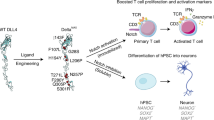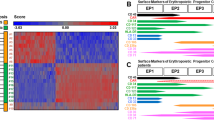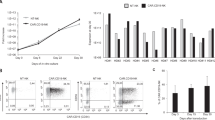Abstract
To examine the role of the Notch ligand Delta-4 on hematopoietic stem cells, human CD34+CD38low cord blood cells were cocultured on S17 cells transduced with transmembrane Delta-4 (mbD4/S17) or an empty vector (C/S17). By the end of a 3-week culture, mbD4/S17 induced a 25-fold reduction in nucleated cell production, as compared to C/S17, by maintaining a higher proportion of cells in G0/G1 phase. A specific retention of a high proportion of CD34+ cells throughout the culture was observed with mbD4/S17, contrary to C/S17. Although mbD4/S17 promoted expansion of cells with the phenotype of committed lymphoid precursors (CD34+CD7+CD45RA+), these cells still retained their myeloid differentiation potential. mbD4/S17 maintained a higher LTC-IC frequency in output CD34+ cells, compared to C/S17, as in the subsets of cells having completed the same number of divisions on mbD4/S17. A Delta4-Fc protein (extracellular part of human Delta4 fused to Fc human IgG1 portion), immobilized on plastic, also reduced cell production and retained the LTC-IC potential. Transplantation of cells grown on mbD4/S17 into NOD/SCID mice showed no significant enhancement of the long-term repopulating ability. Thus, Delta4 appears to inhibit hematopoietic stem cell proliferation, in association with the maintenance of short-term lymphoid and myeloid repopulation capacity.
This is a preview of subscription content, access via your institution
Access options
Subscribe to this journal
Receive 12 print issues and online access
$259.00 per year
only $21.58 per issue
Buy this article
- Purchase on Springer Link
- Instant access to full article PDF
Prices may be subject to local taxes which are calculated during checkout








Similar content being viewed by others
References
Orkin SH . Diversification of haematopoietic stem cells to specific lineages. Nat Rev Genet 2000; 1: 57–64.
Nye JS, Kopan R . Developmental signaling. Vertebrate ligands for Notch. Curr Biol 1995; 5: 966–969.
Simpson P . Developmental genetics. The Notch connection. Nature 1995; 375: 736–737.
Milner LA, Bigas A . Notch as a mediator of cell fate determination in hematopoiesis: evidence and speculation. Blood 1999; 93: 2431–2448.
Artavanis-Tsakonas S, Matsuno K, Fortini ME . Notch signaling. Science 1995; 268: 225–232.
Anderson AC, Robey EA, Huang YH . Notch signaling in lymphocyte development. Curr Opin Genet Dev 2001; 11: 554–560.
Karanu FN, Murdoch B, Gallacher L, Wu DM, Koremoto M, Sakano S et al. The notch ligand jagged-1 represents a novel growth factor of human hematopoietic stem cells. J Exp Med 2000; 192: 1365–1372.
Karanu FN, Murdoch B, Miyabayashi T, Ohno M, Koremoto M, Gallacher L et al. Human homologues of Delta-1 and Delta-4 function as mitogenic regulators of primitive human hematopoietic cells. Blood 2001; 97: 1960–1967.
Tsai S, Fero J, Bartelmez S . Mouse Jagged2 is differentially expressed in hematopoietic progenitors and endothelial cells and promotes the survival and proliferation of hematopoietic progenitors by direct cell-to-cell contact. Blood 2000; 96: 950–957.
Stier S, Cheng T, Dombkowski D, Carlesso N, Scadden DT . Notch1 activation increases hematopoietic stem cell self-renewal in vivo and favors lymphoid over myeloid lineage outcome. Blood 2002; 99: 2369–2378.
Varnum-Finney B, Xu L, Brashem-Stein C, Nourigat C, Flowers D, Bakkour S et al. Pluripotent, cytokine-dependent, hematopoietic stem cells are immortalized by constitutive Notch1 signaling. Nat Med 2000; 6: 1278–1281.
Ohishi K, Varnum-Finney B, Bernstein ID . Delta-1 enhances marrow and thymus repopulating ability of human CD34(+)CD38(−) cord blood cells. J Clin Invest 2002; 110: 1165–1174.
Varnum-Finney B, Brashem-Stein C, Bernstein ID . Combined effects of Notch signaling and cytokines induce a multiple log increase in precursors with lymphoid and myeloid reconstituting ability. Blood 2002; 101: 1784–1789.
Varnum-Finney B, Purton L, Yu M, Brashem-Stein C, Flowers D, Staats S et al. The Notch ligand, Jagged-1, influences the development of primitive hematopoietic precursor cells. Blood 1998; 91: 4084–4091.
Jones P, May G, Healy L, Brown J, Hoyne G, Delassus S et al. Stromal expression of Jagged 1 promotes colony formation by fetal hematopoietic progenitor cells. Blood 1998; 92: 1505–1511.
Carlesso N, Aster JC, Sklar J, Scadden DT . Notch1-induced delay of human hematopoietic progenitor cell differentiation is associated with altered cell cycle kinetics. Blood 1999; 93: 838–848.
Walker L, Lynch M, Silverman S, Fraser J, Boulter J, Weinmaster G et al. The Notch/Jagged pathway inhibits proliferation of human hematopoietic progenitors in vitro. Stem Cells 1999; 17: 162–171.
Han W, Ye Q, Moore MA . A soluble form of human Delta-like-1 inhibits differentiation of hematopoietic progenitor cells. Blood 2000; 95: 1616–1625.
Rao PK, Dorsch M, Chickering T, Zheng G, Jiang C, Goodearl A et al. Isolation and characterization of the notch ligand delta4. Exp Cell Res 2000; 260: 379–386.
Shutter JR, Scully S, Fan W, Richards WG, Kitajewski J, Deblandre GA et al. Dll4, a novel Notch ligand expressed in arterial endothelium. Genes Dev 2000; 14: 1313–1318.
Yoneya T, Tahara T, Nagao K, Yamada Y, Yamamoto T, Osawa M et al. Molecular cloning of Delta-4, a new mouse and human notch ligand. J Biochem (Tokyo) 2001; 129: 27–34.
Hawley RG, Lieu FH, Fong AZ, Hawley TS . Versatile retroviral vectors for potential use in gene therapy. Gene Therapy 1994; 1: 136–138.
Dugray A, Geay JF, Foudi A, Bonnet ML, Vainchenker W, Wendling F et al. Rapid generation of a tetracycline-inducible BCR-ABL defective retrovirus using a single autoregulatory retroviral cassette. Leukemia 2001; 15: 1658–1662.
Landreth KS, Dorshkind K . Pre-B cell generation potentiated by soluble factors from a bone marrow stromal cell line. J Immunol 1988; 140: 845–852.
Bennaceur-Griscelli A, Tourino C, Izac B, Vainchenker W, Coulombel L . Murine stromal cells counteract the loss of long-term culture-initiating cell potential induced by cytokines in CD34+CD38low/neg human bone marrow cells. Blood 1999; 94: 529–538.
Bennaceur-Griscelli A, Pondarre C, Schiavon V, Vainchenker W, Coulombel L . Stromal cells retard the differentiation of CD34(+)CD38(low/neg) human primitive progenitors exposed to cytokines independent of their mitotic history. Blood 2001; 97: 435–441.
Croisille L, Auffray I, Katz A, Izac B, Vainchenker W, Coulombel L . Hydrocortisone differentially affects the ability of murine stromal cells and human marrow-derived adherent cells to promote the differentiation of CD34++/CD38- long-term culture-initiating cells. Blood 1994; 84: 4116–4124.
Robin C, Pflumio F, Vainchenker W, Coulombel L . Identification of lymphomyeloid primitive progenitor cells in fresh human cord blood and in the marrow of nonobese diabetic-severe combined immunodeficient (NOD-SCID) mice transplanted with human CD34(+) cord blood cells. J Exp Med 1999; 189: 1601–1610.
Hao Q, Zhu J, Price MA, Payne KJ, Barsky LW, Crooks GM . Identification of a novel, human multilymphoid progenitor in cord blood. Blood 2001; 97: 3683–3690.
Petzer AL, Hogge DE, Landsdorp PM, Reid DS, Eaves CJ . Self-renewal of primitive human hematopoietic cells (long-term-culture-initiating cells) in vitro and their expansion in defined medium. Proc Natl Acad Sci USA 1996; 93: 1470–1474.
Ohishi K, Varnum-Finney B, Flowers D, Anasetti C, Myerson D, Bernstein ID . Monocytes express high amounts of Notch and undergo cytokine specific apoptosis following interaction with the Notch ligand, Delta-1. Blood 2000; 95: 2847–2854.
Ohishi K, Varnum-Finney B, Serda RE, Anasetti C, Bernstein ID . The Notch ligand, Delta-1, inhibits the differentiation of monocytes into macrophages but permits their differentiation into dendritic cells. Blood 2001; 98: 1402–1407.
Dorsch M, Zheng G, Yowe D, Rao P, Wang Y, Shen Q et al. Ectopic expression of Delta4 impairs hematopoietic development and leads to lymphoproliferative disease. Blood 2002; 100: 2046–2055.
Sriuranpong V, Borges M, Ravi R, Arnold D, Nelkin B, Baylin S et al. Notch signaling induces cell cycle arrest in small cell lung cancer cells. Cancer Res 2001; 61: 3200–3205.
Ronchini C, Capobianco AJ . Induction of cyclin D1 transcription and CDK2 activity by Notch(ic): implication for cell cycle disruption in transformation by Notch(ic). Mol Cell Biol 2001; 21: 5925–5934.
Kollet O, Peled A, Byk T, Ben-Hur H, Greiner D, Shultz L et al. beta2 microglobulin-deficient (B2m(null)) NOD/SCID mice are excellent recipients for studying human stem cell function. Blood 2000; 95: 3102–3105.
Ito M, Hiramatsu H, Kobayashi K, Suzue K, Kawahata M, Hioki K et al. NOD/SCID/gamma(c)(null) mouse: an excellent recipient mouse model for engraftment of human cells. Blood 2002; 100: 3175–3182.
Zandstra PW, Lauffenburger DA, Eaves CJ . A ligand–receptor signaling threshold model of stem cell differentiation control: a biologically conserved mechanism applicable to hematopoiesis. Blood 2000; 96: 1215–1222.
Acknowledgements
We thank midwifes and nurses who helped us to collect cord blood samples. We are indebted to AMGEN (Thousand Oaks, CA, USA) for providing us with rhu-SCF, KIRIN (Tokyo, Japan) for rhu-PEG-MDGF, IMMUNEX for Flt3-ligand, Novartis for rhu-IL-3, CILAG for rhuEPO, and Dr K Mori (Niigata University, Niigata, Japan) for the MS-5 cell line, and Dr Dorshkind for providing us with S17 cells. We thank Dr J Morgenstern and Dr G Laramee for providing the retroviral constructs, V Schiavon and Y Lécluse for performing the cell sorting, M Jandrot-Perrus for allowing us to purify Delta4-Fc in her laboratory, P Ardouin for mice facilities. This work was supported by INSERM, and a grant from CRC (Contrat de Recherche Clinique, CRC no. 2000.10, Institut Gustave Roussy), and a grant from ARC (Association de recherche contre le Cancer, no. 4300).
Author information
Authors and Affiliations
Corresponding author
Rights and permissions
About this article
Cite this article
Lauret, E., Catelain, C., Titeux, M. et al. Membrane-bound Delta-4 Notch ligand reduces the proliferative activity of primitive human hematopoietic CD34+CD38low cells while maintaining their LTC-IC potential. Leukemia 18, 788–797 (2004). https://doi.org/10.1038/sj.leu.2403288
Received:
Accepted:
Published:
Issue Date:
DOI: https://doi.org/10.1038/sj.leu.2403288
Keywords
This article is cited by
-
Notch Signaling in the Regulation of Hematopoietic Stem Cell
Current Stem Cell Reports (2017)
-
Notch signaling in differentiation and function of dendritic cells
Immunologic Research (2008)



